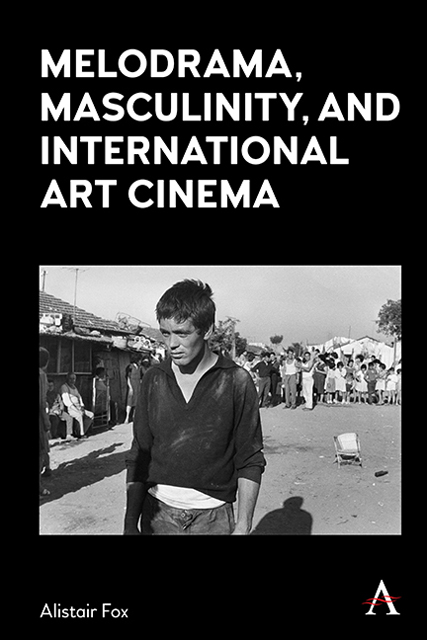Book contents
- Frontmatter
- Dedication
- Contents
- List of Figures
- Preface
- Acknowledgments
- Introduction
- Chapter 1 Italian Neorealism and the Emergence of the Male Melodrama: Vittorio De Sica’s Bicycle Thieves (1948) and Umberto D. (1952)
- Chapter 2 The Migration of Male Melodrama into Non-Western Cultures: Satyajit Ray’s The Apu Trilogy (1955–59) and “Fourth Cinema”
- Chapter 3 Hollywood Melodrama as a Vehicle for Self-Projection: Vincente Minnelli’s Tea and Sympathy (1956) and Home from the Hill (1960)
- Chapter 4 The Political Turns Personal: Neo-Neorealism and Pier Paolo Pasolini’s Accattone (1961)
- Chapter 5 Personal Cinema as Psychodrama: Ingmar Bergman’s Wild Strawberries (1957), Winter Light (1963) and Hour of the Wolf (1968)
- Chapter 6 François Truffaut and the Tyranny of Romantic Obsession: The Soft Skin (1964), Mississippi Mermaid (1969) and The Woman Next Door (1981)
- Chapter 7 Figuring an Authorial Fantasmatic: Jacques Demy’s The Umbrellas of Cherbourg (1964), A Room In Town (1982) and Parking (1985)
- Chapter 8 Rainer Werner Fassbinder and the Emergence of Queer Cinema: The Merchant of Four Seasons (1972), Fox and His Friends (1975) and In a Year with 13 Moons (1978)
- Chapter 9 Visual Aestheticism and the Queer Prestige Melodrama: Call Me by Your Name (2017) and Luca Guadagnino’s Desire Trilogy
- Conclusion
- List of Films Cited
- Select Bibliography
- Index
Chapter 1 - Italian Neorealism and the Emergence of the Male Melodrama: Vittorio De Sica’s Bicycle Thieves (1948) and Umberto D. (1952)
Published online by Cambridge University Press: 10 January 2023
- Frontmatter
- Dedication
- Contents
- List of Figures
- Preface
- Acknowledgments
- Introduction
- Chapter 1 Italian Neorealism and the Emergence of the Male Melodrama: Vittorio De Sica’s Bicycle Thieves (1948) and Umberto D. (1952)
- Chapter 2 The Migration of Male Melodrama into Non-Western Cultures: Satyajit Ray’s The Apu Trilogy (1955–59) and “Fourth Cinema”
- Chapter 3 Hollywood Melodrama as a Vehicle for Self-Projection: Vincente Minnelli’s Tea and Sympathy (1956) and Home from the Hill (1960)
- Chapter 4 The Political Turns Personal: Neo-Neorealism and Pier Paolo Pasolini’s Accattone (1961)
- Chapter 5 Personal Cinema as Psychodrama: Ingmar Bergman’s Wild Strawberries (1957), Winter Light (1963) and Hour of the Wolf (1968)
- Chapter 6 François Truffaut and the Tyranny of Romantic Obsession: The Soft Skin (1964), Mississippi Mermaid (1969) and The Woman Next Door (1981)
- Chapter 7 Figuring an Authorial Fantasmatic: Jacques Demy’s The Umbrellas of Cherbourg (1964), A Room In Town (1982) and Parking (1985)
- Chapter 8 Rainer Werner Fassbinder and the Emergence of Queer Cinema: The Merchant of Four Seasons (1972), Fox and His Friends (1975) and In a Year with 13 Moons (1978)
- Chapter 9 Visual Aestheticism and the Queer Prestige Melodrama: Call Me by Your Name (2017) and Luca Guadagnino’s Desire Trilogy
- Conclusion
- List of Films Cited
- Select Bibliography
- Index
Summary
While isolated examples of male melodrama can be found in films made prior to World War II, it was the discovery of a new form of cinematic language with the advent of Italian neorealism, combined with the traumatic social conditions in Europe in the aftermath of the War, that provided the impetus for the emergence of the male melodrama as a significant new genre. In France, Jean Renoir foreshadowed this new kind of male-focused movie with his film Toni (1935), which explores the emotional tribulations of a dispossessed Italian immigrant who, seeking employment in Southern France, falls in love with a woman whom he loses to another man and then is killed after taking the blame when she shoots her abusive husband. In his choice of theme, his use of non-professional actors, and his decision to shoot on-location rather than in a studio, Renoir provided a model that would directly encourage others, like Luchino Visconti, who had been Renoir’s assistant on the film, to make similar movies, such as Obsession (Ossessione, Luchino Visconti, 1943).
The new cinematic language made possible by lighter equipment and liberation from the need for studio-enabled directors, as Roberto Rossellini, one of the leaders of the neorealist movement, put it, “to speak in the most direct possible way.” That new manner of speaking, in turn, lent itself admirably to the portrayal of masculine emotional experience once the focus of attention shifted from a largely social and political perspective to one that viewed the political through the lens of the personal.
One can identify three stages by which this shift occurred. In the earliest phase, as in Rossellini’s Rome, Open City (Roma città aperta, 1945) and Paisan (Païsà, 1946), the primary motive was sociological and political. In Paisan, for example, which is set during the Italian campaign when the Allies invaded Italy from the south in an attempt to dislodge the occupying Nazi German forces, the film’s six episodes are all constructed around situations that depend for their cathartic effect on irony residing in the contrast between the perspectives and motives of the characters who are primarily involved in the events of each episode and the contradictory assumptions and intentions of those with whom the allied forces, and those who are on their side, come into conflict.
- Type
- Chapter
- Information
- Melodrama, Masculinity and International Art Cinema , pp. 15 - 34Publisher: Anthem PressPrint publication year: 2022

